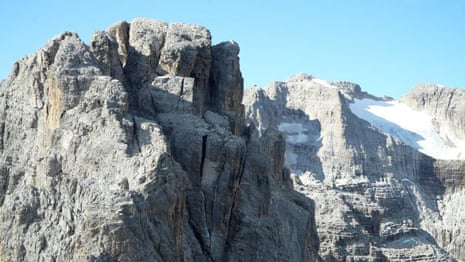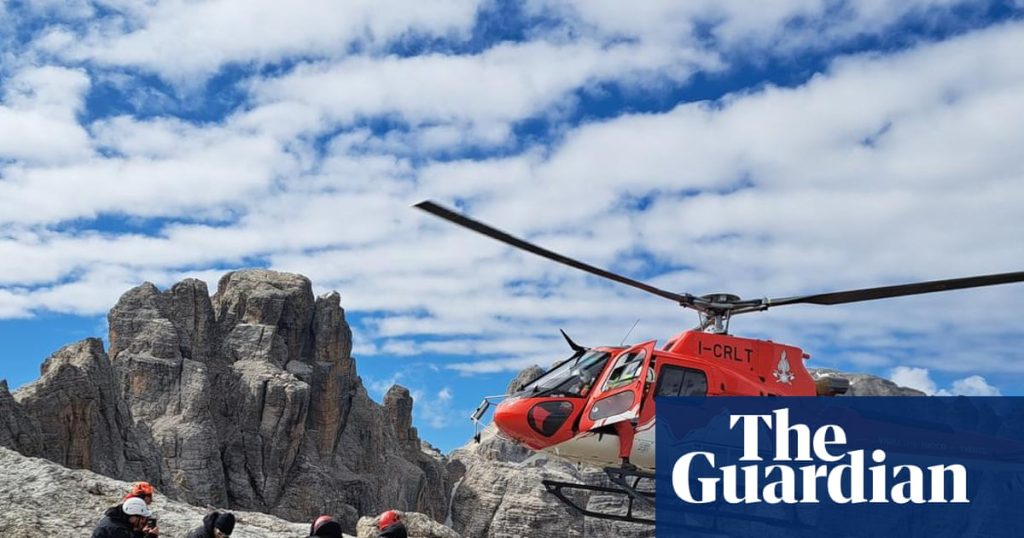Hundreds of hikers and tourists were evacuated and dozens of trails closed after a series of rockfalls on the slopes of Cima Falkner in the Brenta Dolomites in the north of Italy, as experts warned of a sharp rise in landslides in the area linked to thawing permafrost.
In recent days, visitors reported hearing loud booms followed by rockfalls and thick clouds of dust rising from Monte Pelmo in the Val di Zoldo after rocky pinnacles broke away and crashed down into the valley below in the municipality of Selva di Cadore in Italy’s Belluno province.
Another collapse was recorded on Cima Falkner, where experts say the entire area is undergoing a process of erosion linked to rising temperatures and the wider climate emergency. No one was injured and the falling debris came to a stop higher up the mountain.

“Multiple rockfalls have occurred on both the western and eastern slopes of Cima Falkner in the Brenta Group,” read a statement by authorities in the region of Trentino-Alto Adige. “As a result, all climbing routes and hiking trails directly affected by the area have been immediately closed.
“All hikers in the area have been evacuated. We urge everyone to pay maximum attention and strictly follow the ordinances to ensure their own safety.”
Following reports of rockfalls, a technical inspection was conducted on Tuesday by the geological service with the support of a helicopter unit, which confirmed that “the entire summit is affected by an ongoing geomorphological process, likely linked to permafrost degradation”.
Rockfalls have always occurred in the Dolomites, but experts this year warned of a striking rise in the number of collapses, driven by extreme heat and weather events intensified by the climate crisis.
“Never before have we seen such an incredible increase in rockfalls,” Piero Carlesi, president of the scientific committee of the Italian Alpine Club (CAI), told la Repubblica. “Landslides are on the rise, and the main cause is the climate crisis. There’s no doubt about it.”
He added: “Mountains, by definition, are destined to collapse – they won’t remain as we know them for ever. What’s different now is that we’re seeing a clear acceleration of these processes, driven by heat and extreme weather events intensified by the climate crisis.”
Cold temperatures, causing water seeping into rock fractures to freeze, acted as a kind of glue, holding the rocks together. But now, Carlesi said, with rising temperatures, that glue was disappearing and fractured rock was increasingly breaking off and tumbling down gullies. “It’s happening more and more often,” he said.
Last year, Italian scientists who took part in a campaign launched by the environmentalist group Legambiente said the Marmolada glacier – the largest and most symbolic in the Dolomites – could melt completely by 2040.
Their report said Marmolada was losing between 7cm and 10cm of depth a day and that over the past five years, 70 hectares (173 acres) of its surface had disappeared.
Since the beginning of scientific measurements in 1888, the Marmolada glacier has withdrawn by 1,200 metres in an “irreversible coma”.
The planet’s most important stories. Get all the week’s environment news – the good, the bad and the essential
Privacy Notice: Newsletters may contain info about charities, online ads, and content funded by outside parties. For more information see our Privacy Policy. We use Google reCaptcha to protect our website and the Google Privacy Policy and Terms of Service apply.
after newsletter promotion
In 2022, a collapse on the Marmolada mountain sent an avalanche of ice, snow and rock downslope, killed 11 people.
Erosion and rockfalls are on the rise not only in the Dolomites but across the entire Alpine range, according to mountaineers and experts. In late June 2025, Mont Blanc experienced a record-breaking heatwave with temperatures remaining above zero for an extended period at high altitudes, including the summit.
Bernard Vion, a 66-year-old mountain guide, has been walking and climbing in the French Alps around Pralognan-la-Vanoise since he was a child and accompanies visitors on climbs. He said rockfalls and other dangers caused by climate change had complicated work for him and his colleagues.
“We have never seen rock falls of such intensity and regularity before. The permafrost, which is like a kind of cement holding the rocks together, is melting, meaning they have no cohesion and they collapse,” he said.
Vion opened his phone to show a message from another guide with pictures of a large rockfall near a mountain refuge at about 2,800 metres above Pralognan-la-Vanoise on Monday. “He was really shocked. He said he never expected it to happen there,” Vion said.
“For several years now we have had to develop the ability to observe these phenomenon and spot the warning signs. In some cases we’ve had to totally modify our itineraries to reduce the risk to our clients. Even for us guides this is difficult and I worry about amateur climbers who don’t have the same mountain culture.”
He said “of course” this was due to climate breakdown. “You’d have to be blind not to see it. Anyone who doubts this should come to the mountains.”

